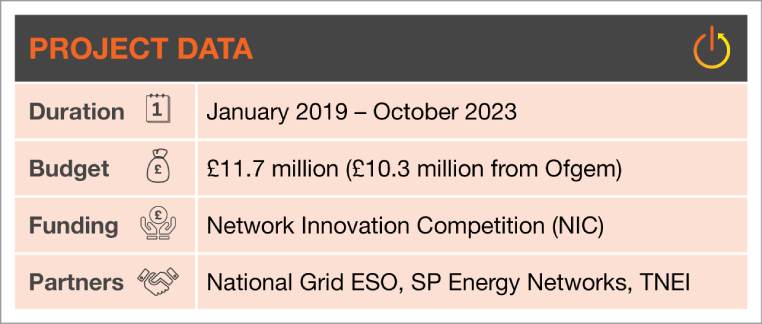Here you can find out about the Distributed ReStart project. Learn about the project’s benefits, its partners, and the workstreams that delivered its outputs.
What was the Distributed ReStart project?
The Distributed ReStart project was a world-first initiative. The project explored how distributed energy resources (DER) such as solar, wind and hydro, can be used to restore power to the transmission network in the unlikely event of a blackout – a process known as electricity system restoration or black start.
The project was a three-way partnership bringing together the expertise of National Grid Electricity System Operator (ESO), SP Energy Networks (SPEN) and TNEI (a specialist energy consultancy).

Learn about the Distributed ReStart project
This video will give you a more detailed explanation of the project, and a summary of its final outputs and conclusions.
Project details
Details of the project and its successful delivery of all objectives required by Ofgem can be found below. This includes the additional development and testing of a prototype Distribution Restoration Zone Controller (DRZC), which went beyond the original scope of the project.
The project delivery section also gives details of the final reports that support the successful delivery of the project with our final recommendations.
Distributed ReStart was a three-way partnership which brought together the expertise of National Grid Electricity System Operator (ESO), SP Energy Networks (SPEN) and TNEI (a specialist energy consultancy).
Ofgem provided £10.3 million of the project’s total budget of £11.7 million, with the balance of £1.4 million shared between the partners.
You can find out more about National Grid ESO on the who we are section of our website.
SP Energy Networks
SP Energy Networks (SPEN) is a licensed electricity distribution network operator (DNO) for central and southern Scotland and parts of England and north Wales. SPEN also operates the transmission network in central and southern Scotland.
TNEI
TNEI is an independent specialist energy consultancy. It offers a range of skills tailored to the challenges and opportunities associated with increased distributed renewable generation, and the integration of low carbon technology.
Distributed ReStart demonstrated a world first by coordinating distributed energy resources (DER) for a “bottom-up” approach to an electricity system restoration service.
Electricity system restoration is currently a “top-down” transmission-led service using large fossil fuel generators, like coal-fired power stations, to restart the transmission network.
DERs include renewable sources of energy like:
- natural gas turbines
- biomass generators
- embedded hydro-power stations
- wind turbines
- solar panels
DERs provide a cleaner and greener alternative to large fossil fuel generators. Although the scale of production for DERs is typically smaller, their enormous growth on distribution networks presents an opportunity to co-ordinate an electricity system restoration service using renewables.
The key challenge for the project was how to bring the organisational coordination, the commercial and regulatory frameworks, and the power engineering solutions together to achieve an electricity system restoration from DERs.
The project has successfully met all its agreed objectives and deliverables.
Our Closedown Report shows that project has not only successfully delivered on all 10 of its objectives as defined and agreed in our Project Direction but has also gone further than originally scoped. This included the build and test of a Distribution Restoration Zone Controller (DRZC) prototype that allows for automation of the creation and stabilisation of a local power island.
The project delivered across all the main workstreams and has produced several key outputs as per the NIC bid requirements and our delivery criteria.
These key outputs are fully described in detail in our Final Findings and Proposals report.
Workstreams
Our Project Direction workstream managed the governance of the project, and Design Assurance provided technical advice to ensure we focused on the right areas. The Stakeholder Advisory Panel provided advice and suggestions from an industry perspective.
Four additional workstreams covered the areas needed to enable an electricity system restoration from DERs.
The power engineering and trials work stream assessed the capability of distribution networks and installed DERs to deliver an effective electricity system restoration service.
It identified the technical requirements that should apply on an enduring basis. This was done through detailed analysis of case studies and progression through multiple stages of review and testing.
The organisational, systems and telecommunications workstream considered the restoration process. This included the different roles, responsibilities and relationships needed across the industry to achieve an effective electricity system restoration from DER service.
It specified the requirements for information systems and telecommunications, recognising the need for resilience and the challenges of coordinating electricity system restoration across many parties.
The procurement and compliance work stream considered the best way to deliver the concept for end consumers by:
- exploring the options and trade-offs between competitive procurement solutions and mandated elements
- making recommendations on the procurement strategy
- aiming to be as open and transparent as possible, while reflecting wider industry discussions on related topics like the DSO transition and whole system planning
- feeding into BAU activities to make changes as necessary in codes and regulations
The knowledge and dissemination workstream focused on the findings from this project. These will be of immense value to the industry, both locally and internationally, as energy systems seek to decarbonise and decentralise.
The project's findings are being disseminated to a variety of stakeholders. These range from DERs and network operators through to academics, policy makers and end consumers.
Stakeholder engagement has also been important for incorporating valuable feedback into the project.
This organisational chart shows the structure and flow of the project’s workstreams and stakeholders.

Follow-on live trial 2023
The Redhouse live trial findings will be published within a follow-on Power Engineering and Trials report, which will be available on the project’s website.
Please subscribe to our database to keep updated on the progress of this key live trial.

Benefits for net zero, DERs and consumers
Removing our dependence on large fossil fuel generators for electricity system restoration services will help achieve a net zero carbon grid by 2025. It will also enable the government’s net zero carbon target for 2050.
DERs and flexible demand companies would benefit from revenue for the provision of electricity system restoration services. Increased competition will also reduce electricity system restoration costs, with savings passed on to consumers through reduced levies.

Join our mailing list
Join our mailing list to receive publication updates and links to our latest guidance materials.









